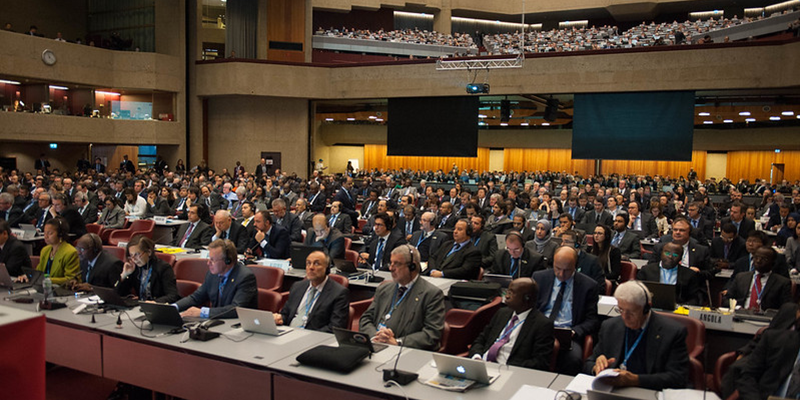Battle over Airwaves at International Treaty Conference Could Disrupt Global Economy
Los Angeles: A clash between the US and Europe over 5G’s future development at The World Radiocommunication Conference 2019 (WRC-19) – taking place in Egypt from 28 October to 22 November 2019 – could risk $565bn of economic expansion globally over the next 15 years, warned the GSMA today.
This economic growth from next-generation 5G services depends on the availability of a specific strand of radio frequencies, known as ‘millimetre wave’ frequencies, which are set to be identified for use by mobile operators at WRC-19. However, efforts by Europe to constrain the use of these critical frequencies due to claims of potential interference with some space services has 5G’s future hanging in the balance.
“The stakes are high – a new generation of 5G services and the economic growth accompanying them will depend on the spectrum decisions taken at WRC-19,” said Brett Tarnutzer, Head of Spectrum, GSMA. “We are calling for Europe to join the US in taking a pro-5G stance at WRC-19 to protect its digital future. Some administrations are still determined to limit mobile use of airwaves that 5G requires to reach its full potential. This protectionist attitude will have consequences for our global economy if allowed to prevail.”
“Our focus is on ensuring that all regions are on board with the win-win resolution that will allow for robust 5G deployments globally while protecting satellite interests worldwide,” said Tom Power, Senior Vice President & General Counsel, CTIA. “Reports indicate that the fastest 5G peak speeds today are in the US, and that’s because the US was the first to deploy mmWave. The benefits of using this spectrum are clear but only through global harmonization at WRC-19 will all regions gain the greatest value.”
Benefits of mmWave spectrum
mmWave bands are critical to providing ultra-high speeds and ultra-high capacity for a wide range of consumer, business and government services that require almost instantaneous delivery of large amounts of data. This includes entertainment services such as downloading ultra-high definition movies in seconds, virtual and augmented reality applications, remote surgery with ‘haptic’ feedback, precise control of industrial devices and robots, and autonomous vehicles.
Three thousand delegates from over 190 nations will solutions-and-impact/connectivity-for-good/public-policy/regulatory-environment/mobile-energy-efficiencyt at WRC-19 to agree on how this spectrum may be used. Different countries may have different approaches and strategies, but WRC is the solutions-and-impact/connectivity-for-good/public-policy/regulatory-environment/mobile-energy-efficiencyting point for all nations to maximize the potential for 5G within their borders by thinking globally. The process of harmonization at WRC-19 delivers global roaming and economies of scale for vendors and carriers, and that translates into lower costs, faster deployments and greater convenience for consumers.
Clash over airwaves at WRC-19
The build-up to WRC-19 is a four-year process and the use of mmWave spectrum has been the subject of intense technical study throughout. WRC-19 is the final decision after a lot of analysis and technical study.
Technical studies supported by the Americas, Africa and Arab states, have demonstrated that 5G using mmWave spectrum can co-exist safely and efficiently alongside weather-sensing services, commercial satellite services and others. These were conducted within the ITU, a UN agency. In the US, the FCC developed emission limits on 5G to protect weather sensors in nearby spectrum bands. Ahead of WRC-19, the FCC and the State Department also worked with regulators from other countries throughout the Americas, achieving consensus at the CITEL conference in Ottawa in August.
Despite this body of evidence, European countries are looking to limit the use of mmWave spectrum by setting protective technical conditions.
“It is important to follow studies which make realistic assumptions about how networks will function and make the best use of the spectrum for all,” added Brett Tarnutzer. This approach is being followed in the Americas, Africa and the Middle East but we need to find a global solution, including Europe. Large ‘guard bands’ will be needed – that is empty tranches of unused spectrum separating services – if we have technical limits which are too severe. This will restrict the economic benefit we can gain from finite spectrum resources and harm consumers and industry.”
-ENDS-
About the GSMA
The GSMA represents the interests of mobile operators worldwide, uniting more than 750 operators with over 350 companies in the broader mobile ecosystem, including handset and device makers, software companies, equipment providers and internet companies, as well as organisations in adjacent industry sectors. The GSMA also produces the industry-leading MWC events held annually in Barcelona, Los Angeles and Shanghai, as well as the Mobile 360 Series of regional conferences.
For more information, please visit the GSMA corporate website at www.gsma.com. Follow the GSMA on Twitter: @GSMA.
Media Contacts:
For the GSMA
Alia Ilyas
+44 (0)7970 637622
[email protected]
GSMA Press Office
[email protected]



